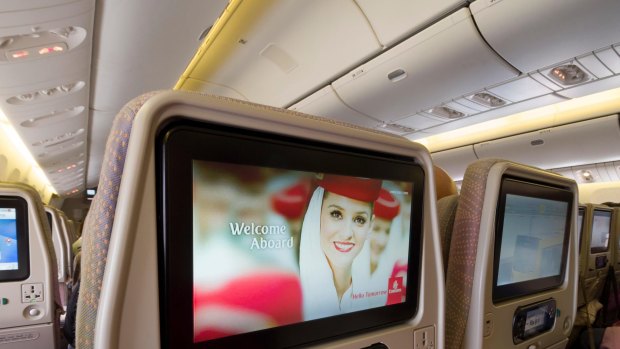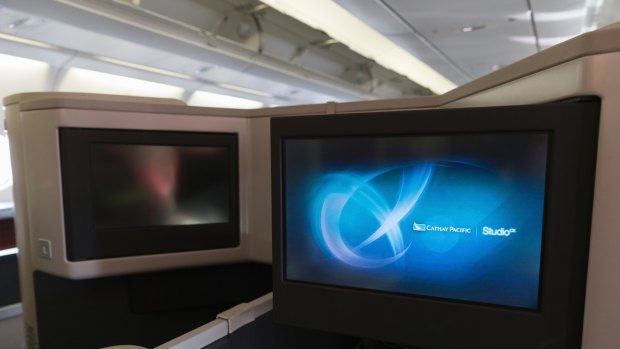This was published 8 years ago
Inflight entertainment options on planes expand
By ELAINE GLUSAC

Entertainment system screens inside the cabin of a Emirates Boeing 777.Credit: Alamy
With more in-flight entertainment than ever, the longest flights can often seem short these days. On a recent trip to Hong Kong on Cathay Pacific, for example, I could build a list of video favourites from more than 100 movies, with options including new Oscar nominees like American Sniper and Mr. Turner as well as classics like Casablanca.
This sort of experience was not a possibility even a few years ago. But to the good fortune of fliers, especially those on transoceanic journeys, the bulky video systems of the past are disappearing fast. No more watching the same video on a loop or waiting for a flight attendant to turn on the system or shut it off 35 minutes before landing.
With the advent of digital content and onboard Wi-Fi, entertainment options have exploded, offering passengers more diversions in the sky, including content available on your own portable device. It's a small gift from an industry that has largely forsworn many other amenities, like free meals, pillows and blankets, and checked bags.

15.4 inch touchscreen televisions on board Cathay Pacific.Credit: iStock
"Servers have come on the market that are affordable for airlines to use," said Henry Harteveldt, a travel industry analyst and founder of Atmosphere Research Group. "They can have hundreds or thousands of video titles, and as many audio titles, from pop artists to obscure world music and everything in between."
A pioneer in showing live television in the air, JetBlue Airways now offers both free seat-back television shows and Wi-Fi on most of its planes (the whole fleet will be equipped by 2016), enabling passengers to catch a live ballgame while also perusing their email. The airline will also offer content from Amazon Prime for members of the service.
In September, Virgin America will begin operating the first of 10 aircraft equipped with superfast Wi-Fi, allowing users to stream movies or series from their Netflix account. The airline recently introduced high-quality surround sound on some pay-per-view content, including episodes of Game of Thrones. The system, coming to all planes next year, also features retro games like Pac-Man.
Wi-Fi has also been a boon for no-frills airlines like Southwest, which never installed heavy entertainment systems in the first place to save money. Southwest now offers satellite-based Wi-Fi for domestic flights on about 80 per cent of its fleet, with gate-to-gate connectivity for passengers with their own electronic devices.
Passengers can view free live television, stream music or send messages free, and watch pay-per-view movies. Southwest, however, restricts high-bandwidth streaming and does not allow passengers to stream movies from sites like Netflix or Hulu or use videophone services like Skype.
Given that most fliers now carry at least one electronic device, like a smartphone or tablet, could in-seat screen technology disappear in the not-too-distant future? Some travel analysts think so. On El Al, which started a Boston-to-Tel Aviv route in late June, passengers download an app or software on their own device, which allows them to choose from 50 movies, HBO series, TV sitcoms, music channels and more. Passengers who don't have their own device can rent one from the airline, for about $US37.50.
Alaska Airlines has a similar offer for video content on flights of more than 3.5 hours. Air France has an app that downloads newspapers and magazines free as long as 30 hours before a flight.
Airlines have also taken advantage of the larger digital bandwidth to offer unique programming. Alaska features videos from the Seattle International Film Festival. Hawaiian Airlines has a video channel with Hawaiian music videos and audio channels for passengers to snooze to the splash of waterfalls and the sound of wind through the palms.
The quirkiest video programming perhaps belongs to British Airways, which offers a series of channels to help fliers relax. Offerings include footage of puppies and kittens, a video series on meditation, and Slow TV, with marathon coverage of someone knitting or an unedited 7.5-hour train trip.
Some airplanes, like the Airbus A380, flown by airlines from the Middle East and Asia and a handful of European carriers, have cameras that stream takeoffs and landings. Passengers can watch the scenery below on one channel or take in the view from the cockpit on another.
Most investments have been made in video programming, but a number of airlines are focusing on their audio content too. Delta Air Lines offers its Delta Artist Spotlight, highlighting emerging artists including Scottish electro-pop band Chvrches, US singer-songwriter Banks and, when it was introduced in June 2014, a pre-Grammy Sam Smith.
While Wi-Fi access has improved entertainment options even on short flights within the United States, features generally increase with distance flown, and seat-back screens have essentially become standard on long-haul, transoceanic routes.
"In-flight entertainment is still something that engages customers and keeps them coming back," said Paul Ng, manager of in-flight entertainment for Singapore Airlines. "On a 12- to 15-hour journey you need something to keep them entertained."
In August, Singapore will introduce a system for premium economy cabins that are coming to the United States in December. It will have a swipe-screen remote control that also serves as a mini second screen, allowing passengers to look at a flight map, play a game or learn a foreign language while watching videos on a 13.3-inch monitor.
Carriers are also paying special attention to children. On more than 200 domestic aircraft with streaming video service, American Airlines offers two free family movies per month (recently they were "Thor" and "Saving Mr. Banks") as well as more titles to rent. Air France offers an app that allows children to digitally colour pictures and download free games before takeoff.
If you prefer social diversion, KLM's Meet & Seat service allows passengers to upload personal information and pick a seat next to someone with similar interests. Virgin America allows you to send a drink to a fellow passenger through its system, and Etihad lets you e-chat with other people aboard.
Not every long-haul aircraft has the latest gizmos, however. On a recent flight from Miami to Montevideo, Uruguay, an older American Airlines aircraft had a single boxy monitor in the front of the economy cabin. It was broken. I might have prepared myself better for it by checking SeatGuru, which identifies in-flight amenities including audio, video, AC power and Internet access. Fortunately, during the overnight flight, as most passengers slept, few seemed to care.
The New York Times
Sign up for the Traveller newsletter
The latest travel news, tips and inspiration delivered to your inbox. Sign up now.